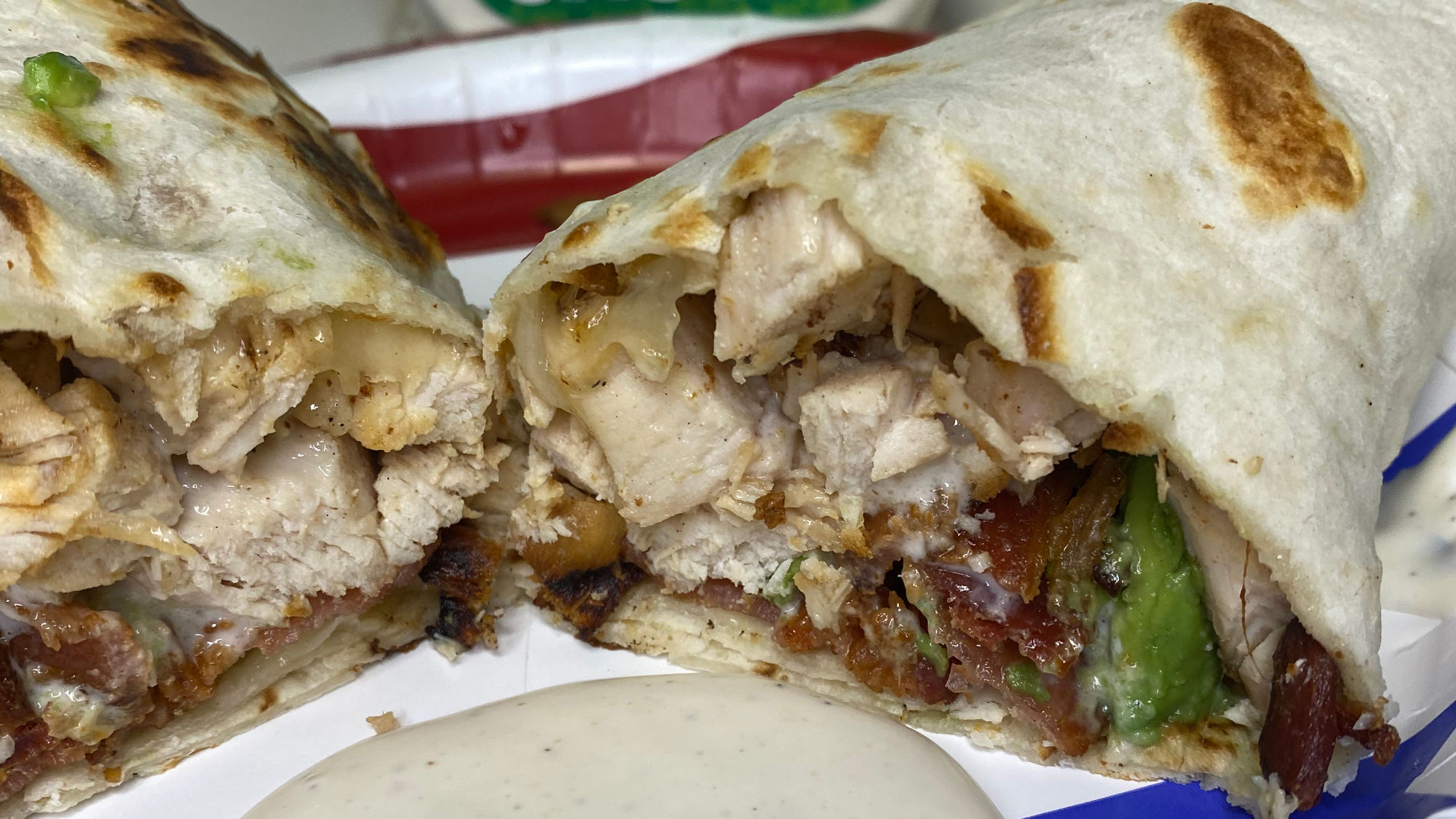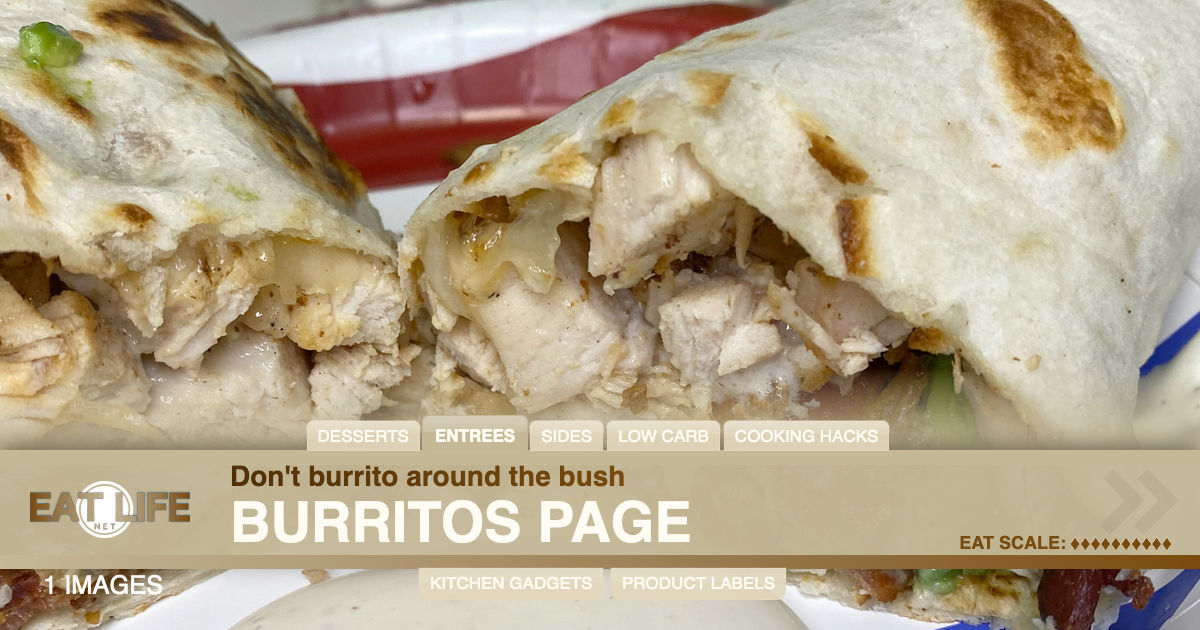Recipes
Burrito
A burrito is a dish in Mexican and Tex-Mex cuisine that took form in Ciudad Juarez, consisting of a flour tortilla wrapped into a sealed cylindrical shape around various ingredients. The tortilla is sometimes lightly grilled or steamed to soften it, make it more pliable, and allow it to adhere to itself. Burritos are often eaten by hand, as their tight wrapping keeps the ingredients together. Burritos can also be served "wet", i.e., covered in a savory and spicy sauce, when they would be eaten with a fork and knife.Burritos are filled with savory ingredients, most often a meat such as beef, chicken, or pork, and often include other ingredients, such as rice, cooked beans (either whole or refried), vegetables, such as lettuce and tomatoes, cheese, and condiments such as salsa, pico de gallo, guacamole, or crema.
WikipediaBurritos are often contrasted with similar dishes
- Tacos A small hand-sized tortilla is folded in half around the ingredients rather than wrapped and sealed
- Enchiladas Corn masa tortillas covered in a savory sauce, to be eaten with a fork and knife
WikipediaThe word burrito means "little donkey" in Spanish possibly deriving from the tendency for burritos to contain a lot of different things - similar to how a donkey would be able to carry lots of stuff.WikipediaAn often repeated piece of folk history is the story of a man named Juan Mendez who sold tacos at a street stand in the Bella Vista neighborhood of Ciudad Juarez during the Mexican Revolution period (1910–1921), while using a donkey as a transport for himself and his food. To keep the food warm, Méndez wrapped it in large homemade flour tortillas underneath a small tablecloth. As the "food of the burrito" (i.e., "food of the little donkey") grew in popularity, "burrito" was eventually adopted as the name for these large tacos.WikipediaAnother origin story tells of Ciudad Juárez in the 1940s, where a street food vendor created the tortilla-wrapped food to sell to poor children at a state-run middle school. The vendor would call the children his "burritos", because burro is a colloquial term for a dunce or dullard. Eventually, the somewhat derogatory but endearing term for the children was transferred to the food that they ate.
- The precise origin of the modern burrito is not known. Some have speculated that it may have originated with vaqueros, the cowboys of northern Mexico in the 19th century.
- Before the development of the modern burrito, the Maya civilization of Mexico used corn tortillas as early as 1500 B.C. to wrap foods, with fillings of chili peppers, tomatoes, mushrooms, squash, and avocados.
- Burritos first appeared on American restaurant menus at the El Cholo Spanish Cafe in Los Angeles during the 1930s.
- Burritos were mentioned in the U.S. media for the first time in 1934, appearing in the Mexican Cookbook, a collection of regional recipes from New Mexico that was written by historian Erna Fergusson.
- In 1956, a frozen burrito was developed in Southern California.
Mexico
Burritos are a traditional food of Ciudad Juárez, a city bordering El Paso, Texas, in the northern Mexican state of Chihuahua, where people buy them at restaurants and roadside stands. Northern Mexican border towns like Villa Ahumada have an established reputation for serving burritos.
- Authentic Mexican burritos are usually small and thin, with flour tortillas containing only one or two of several ingredients: either some form of meat or fish, potato, rice, beans, asadero cheese, chile rajas, or chile relleno.[17] Other ingredients may include: barbacoa, mole, refried beans and cheese (a "bean and cheese" burrito), or deshebrada (shredded slow-cooked flank steak).
San Francisco Mission Burritio
The origins of the Mission burrito or Mission-style burrito can be traced back to San Francisco, in the Mission District taquerías of the 1960s and 1970s. This type of burrito is produced on a steam table assembly line, and is characterized by a large stuffed flour tortilla wrapped in aluminum foil, and may include fillings such as carne asada (beef), Mexican-style rice, whole beans (not refritos), sour cream and onion.
- Febronio Ontiveros claims to have offered the first retail burrito in San Francisco in 1961 at El Faro ("The Lighthouse"), a corner grocery store on Folsom Street.
San Diego
San Diego-style burritos include "California burritos" and carne asada burritos. The style has been described by food writers as an "austere meal of meat, cheese and salsa", a contrast to the Mission-style burrito, which is typically larger and always contains more ingredients.[25] A significant subgroup of Mexican restaurants in San Diego serves burritos described as "no-frills" and, in contrast to Mission-style burritos, the assembly line is not used.
- The California burrito originated at an unknown -berto's named restaurant in San Diego in the 1980s.
Wikipedia In the early 1960s, Roberto Robledo opened a tortilleria in San Diego and learned the restaurant business. Robledo began selling small bean burritos (or burrititos) at La Lomita in the late 1960s, and by 1970, he had established the first Roberto's Taco Shop. By 1999, Roberto's restaurants had expanded to a chain of 60 taco shops offering fresh burritos known for their distinctive quality. Hoping to draw on the prestige of Roberto's, new taco shops in San Diego began using the "-bertos" suffix, with names like Alberto's, Filiberto's, Hilberto's, and others.Los Angeles
The burrito of L.A. itself can take multiple forms, but is almost always dominated by some combination of: refried beans, meat (often stewed beef or chili), and cheese (usually cheddar), with rice and other ingredients typical of Mission burritos offered as add-ons, if at all.
- The most basic version of this burrito consists of only beans and cheese; beyond this, there are the "green chile" and "red chile" burritos, which may simply mean the addition of chiles or a meatless chile sauce to the plain beans (as at Al & Bea's), meat or cheese as well. Rice, again, is rarely included.
Other Burrito Types
- Wet burrito - covered with a red chili sauce similar to a red enchilada sauce, with melted shredded cheese on top.
- Burrito bowl - not technically a burrito despite its name, as it consists of burrito fillings served without the tortilla.
- Breakfast burrito - take on the American breakfast, is composed of breakfast items, with scrambled eggs, wrapped in a flour tortilla.
- Chimichanga - a deep-fried burrito
- Taco - similar to a burrito, but is served open rather than closed, is generally smaller, and is mostly made with corn flour rather than wheat.









